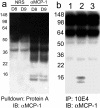Blocking of monocyte chemoattractant protein-1 during tubulointerstitial nephritis resulted in delayed neutrophil clearance
- PMID: 16127145
- PMCID: PMC1698738
- DOI: 10.1016/S0002-9440(10)62039-1
Blocking of monocyte chemoattractant protein-1 during tubulointerstitial nephritis resulted in delayed neutrophil clearance
Abstract
The chemokine monocyte chemoattractant protein (MCP)-1 has been implicated in the monocyte/macrophage infiltration that occurs during tubulointerstitial nephritis (TIN). We investigated the role of MCP-1 in rats with TIN by administering a neutralizing anti-MCP-1 antibody (Ab). We observed significantly reduced macrophage infiltration and delayed neutrophil clearance in the kidneys of TIN model rats treated with the anti-MCP-1 Ab. To exclude the possibility that an observed immune complex could affect the resolution of apoptotic neutrophils via the Fc receptor, TIN model rats were treated with a peptide-based MCP-1 receptor antagonist (RA). The MCP-1 RA had effects similar to those of the anti-MCP-1 Ab. In addition, MCP-1 did not affect macrophage-mediated phagocytosis of neutrophils in vitro. Deposition of the anti-MCP-1 Ab in rat kidneys resulted from its binding to heparan sulfate-immobilized MCP-1, as demonstrated by the detection of MCP-1 in both pull-down and immunoprecipitation assays. We conclude that induction of chemokines, specifically MCP-1, in TIN corresponds with leukocyte infiltration and that the anti-MCP-1 Ab formed an immune complex with heparan sulfate-immobilized MCP-1 in the kidney. Antagonism of MCP-1 in TIN by Ab or RA may alter the pathological process, most likely through delayed removal of apoptotic neutrophils in the inflammatory loci.
Figures










Similar articles
-
Monocyte chemotactic protein-1 regulates leukocyte recruitment during gastric ulcer recurrence induced by tumor necrosis factor-alpha.Am J Physiol Gastrointest Liver Physiol. 2004 Oct;287(4):G919-28. doi: 10.1152/ajpgi.00372.2003. Epub 2004 Jun 17. Am J Physiol Gastrointest Liver Physiol. 2004. PMID: 15205118
-
Cytokine expression, upregulation of intercellular adhesion molecule-1, and leukocyte infiltration in experimental tubulointerstitial nephritis.Lab Invest. 1994 May;70(5):631-8. Lab Invest. 1994. PMID: 7910873
-
Combinatorial model of chemokine involvement in glomerular monocyte recruitment: role of CXC chemokine receptor 2 in infiltration during nephrotoxic nephritis.J Immunol. 2001 May 1;166(9):5755-62. doi: 10.4049/jimmunol.166.9.5755. J Immunol. 2001. PMID: 11313419
-
Monocyte chemoattractant protein-1 (MCP-1): an overview.J Interferon Cytokine Res. 2009 Jun;29(6):313-26. doi: 10.1089/jir.2008.0027. J Interferon Cytokine Res. 2009. PMID: 19441883 Free PMC article. Review.
-
Targeting monocyte chemoattractant protein-1 signalling in disease.Expert Opin Ther Targets. 2003 Feb;7(1):35-48. doi: 10.1517/14728222.7.1.35. Expert Opin Ther Targets. 2003. PMID: 12556201 Review.
Cited by
-
Cirrhotics with Monocyte Chemotactic Protein 1 Polymorphism are at Higher Risk for Developing Spontaneous Bacterial Peritonitis - A Cohort Study.J Clin Transl Res. 2021 May 27;7(3):320-325. eCollection 2021 Jun 26. J Clin Transl Res. 2021. PMID: 34239991 Free PMC article.
-
Plasticity in tumor-promoting inflammation: impairment of macrophage recruitment evokes a compensatory neutrophil response.Neoplasia. 2008 Apr;10(4):329-40. doi: 10.1593/neo.07871. Neoplasia. 2008. PMID: 18392134 Free PMC article.
-
Altered macrophage phenotype transition impairs skeletal muscle regeneration.Am J Pathol. 2014 Apr;184(4):1167-1184. doi: 10.1016/j.ajpath.2013.12.020. Epub 2014 Feb 11. Am J Pathol. 2014. PMID: 24525152 Free PMC article.
-
The chemokine monocyte chemoattractant protein-1 contributes to renal dysfunction in swine renovascular hypertension.J Hypertens. 2009 Oct;27(10):2063-73. doi: 10.1097/HJH.0b013e3283300192. J Hypertens. 2009. PMID: 19730125 Free PMC article.
-
Role of Toll-like receptor 5 in the innate immune response to acute P. aeruginosa pneumonia.Am J Physiol Lung Cell Mol Physiol. 2009 Dec;297(6):L1112-9. doi: 10.1152/ajplung.00155.2009. Epub 2009 Oct 2. Am J Physiol Lung Cell Mol Physiol. 2009. PMID: 19801452 Free PMC article.
References
-
- Zanetti M, Wilson CB. Characterization of anti-tubular basement membrane antibodies in rats. J Immunol. 1983;130:2173–2179. - PubMed
-
- Mampaso FM, Wilson CB. Characterization of inflammatory cells in autoimmune tubulointerstitial nephritis in rats. Kidney Int. 1983;23:448–457. - PubMed
-
- Baggiolini M, Dewald B, Moser B. Human chemokines: an update. Annu Rev Immunol. 1997;15:675–705. - PubMed
-
- Baggiolini M, Moser B, Clark-Lewis I. Interleukin-8 and related chemotactic cytokines. The Giles Filley Lecture. Chest. 1994;105:95S–98S. - PubMed
Publication types
MeSH terms
Substances
Grants and funding
LinkOut - more resources
Full Text Sources
Molecular Biology Databases
Research Materials
Miscellaneous

